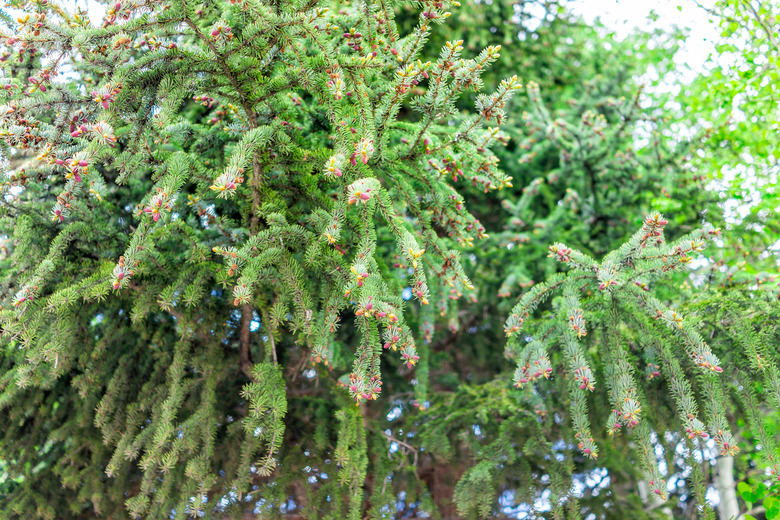How To Prune Weeping Pine Trees
The grace, charm and architectural characteristics of a weeping evergreen tree, such as a pine (Pinus spp.), can add much to a landscape, especially in fall and winter. Weeping Eastern white pine (Pinus strobus 'Pendula,' USDA zones 3-8) reaches a mature height between 6 and 16 feet, while weeping Japanese red pine (Pinus densiflora 'Pendula,' zones 4-8) is a compact cultivar, reaching only 2 feet in height with a 5-foot spread.
Prune Them Selectively
Regardless of their mature size, pruning must be done selectively and lightly, if at all, to retain the attractive form of the plant, and to ensure that the plant is structurally sound. Tip pruning can be done at any point, but major branch pruning should be done when the plant is young.
Trim away any dead, wounded or diseased branches from the plant with a hand pruner, making the cut flush with the trunk where the branch meets it. Leave no more than a 1/4-inch stub. If the branch to be removed is larger than 1/2-inch in diameter, use loppers. Remove dead and diseased branches and twigs any time of year.
Prune at Branch Junction
Tip-prune weeping pine tree branches, as desired for aesthetics, in late winter or early spring by snipping them back to a branch junction. Make the cut with hand pruners 1/4 inch above the junction with another living branch or needle cluster you wish to retain.
Clear the lowermost trunk of scraggly or hidden branches by snipping them flush with the main trunk. This can also be done on the main branches if cluttered branches look unattractive.
Prune Near Soil
Cut back branches that make contact with the soil. Make the cuts on these branches at a junction with another branch or needle cluster that is 6 to 12 inches above the soil. Prune the branches back even further per your aesthetics, depending on how much space you like between the weeping branch tips and the ground.
Remove any branches or twigs that are pulling down the weeping pine tree or making it lopsided. Balance the canopy so that there are branches and foliage on all sides of the trunk.
Other Pruning Tips
Prune pines in early to midwinter when dormant to reduce the oozing or "bleeding" of the sap. Use the clippings for holiday decorations. Regardless of the best pruning and training on a weeping plant, the soil, frequency of wind, or length of branches can all act to topple it. Sometimes a brace or stake is needed to ensure the main trunk can fully support the arching canopy of foliage.
With time, weeping pine branch tips that remain on the soil or mulch may root and grow horizontally like a groundcover. These can be removed.
There should be one main trunk from which all others radiate. Branches that criss-cross each other or put uneven weight loads on a trunk, such as all branches growing out to the right side of the trunk and none on the left side, should be removed or thinned out.
Things to Watch For
Do not cut branches of weeping pines back into lower bare areas and expect regrowth. Pines usually do not spout new buds and needle clusters from older, barren twigs or lowermost parts of branches.
Branch breakage and cracks often manifest themselves after heavy, wet snowfalls or ice storms. Be prepared for residual branch die-back upwards of three to six months after these events.
